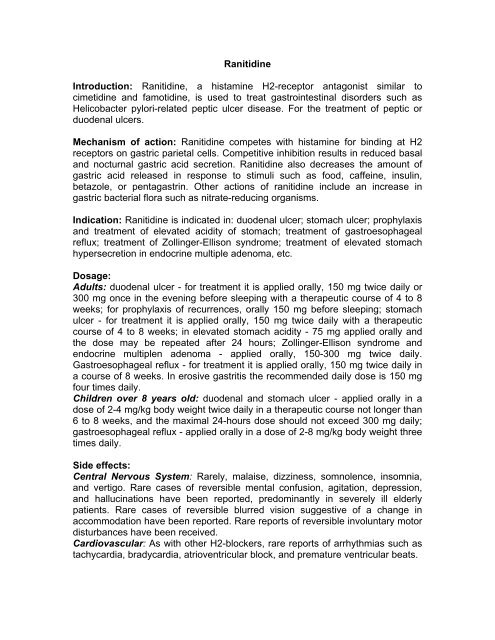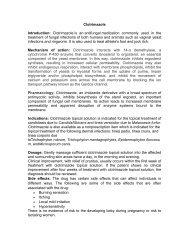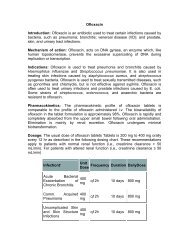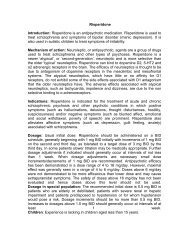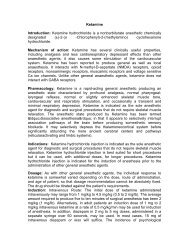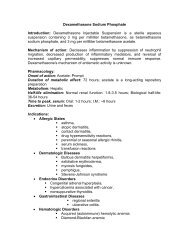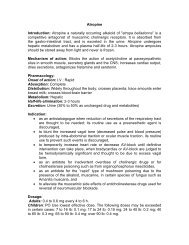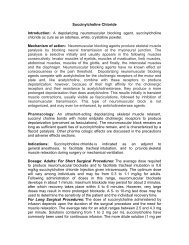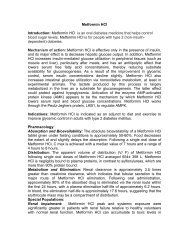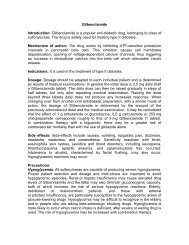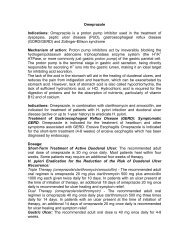Ranitidine Introduction - Pharma Manufacturer
Ranitidine Introduction - Pharma Manufacturer
Ranitidine Introduction - Pharma Manufacturer
You also want an ePaper? Increase the reach of your titles
YUMPU automatically turns print PDFs into web optimized ePapers that Google loves.
<strong>Ranitidine</strong><br />
<strong>Introduction</strong>: <strong>Ranitidine</strong>, a histamine H2-receptor antagonist similar to<br />
cimetidine and famotidine, is used to treat gastrointestinal disorders such as<br />
Helicobacter pylori-related peptic ulcer disease. For the treatment of peptic or<br />
duodenal ulcers.<br />
Mechanism of action: <strong>Ranitidine</strong> competes with histamine for binding at H2<br />
receptors on gastric parietal cells. Competitive inhibition results in reduced basal<br />
and nocturnal gastric acid secretion. <strong>Ranitidine</strong> also decreases the amount of<br />
gastric acid released in response to stimuli such as food, caffeine, insulin,<br />
betazole, or pentagastrin. Other actions of ranitidine include an increase in<br />
gastric bacterial flora such as nitrate-reducing organisms.<br />
Indication: <strong>Ranitidine</strong> is indicated in: duodenal ulcer; stomach ulcer; prophylaxis<br />
and treatment of elevated acidity of stomach; treatment of gastroesophageal<br />
reflux; treatment of Zollinger-Ellison syndrome; treatment of elevated stomach<br />
hypersecretion in endocrine multiple adenoma, etc.<br />
Dosage:<br />
Adults: duodenal ulcer - for treatment it is applied orally, 150 mg twice daily or<br />
300 mg once in the evening before sleeping with a therapeutic course of 4 to 8<br />
weeks; for prophylaxis of recurrences, orally 150 mg before sleeping; stomach<br />
ulcer - for treatment it is applied orally, 150 mg twice daily with a therapeutic<br />
course of 4 to 8 weeks; in elevated stomach acidity - 75 mg applied orally and<br />
the dose may be repeated after 24 hours; Zollinger-Ellison syndrome and<br />
endocrine multiplen adenoma - applied orally, 150-300 mg twice daily.<br />
Gastroesophageal reflux - for treatment it is applied orally, 150 mg twice daily in<br />
a course of 8 weeks. In erosive gastritis the recommended daily dose is 150 mg<br />
four times daily.<br />
Children over 8 years old: duodenal and stomach ulcer - applied orally in a<br />
dose of 2-4 mg/kg body weight twice daily in a therapeutic course not longer than<br />
6 to 8 weeks, and the maximal 24-hours dose should not exceed 300 mg daily;<br />
gastroesophageal reflux - applied orally in a dose of 2-8 mg/kg body weight three<br />
times daily.<br />
Side effects:<br />
Central Nervous System: Rarely, malaise, dizziness, somnolence, insomnia,<br />
and vertigo. Rare cases of reversible mental confusion, agitation, depression,<br />
and hallucinations have been reported, predominantly in severely ill elderly<br />
patients. Rare cases of reversible blurred vision suggestive of a change in<br />
accommodation have been reported. Rare reports of reversible involuntary motor<br />
disturbances have been received.<br />
Cardiovascular: As with other H2-blockers, rare reports of arrhythmias such as<br />
tachycardia, bradycardia, atrioventricular block, and premature ventricular beats.
Gastrointestinal: Constipation, diarrhea, nausea/vomiting, abdominal<br />
discomfort/pain, and rare reports of pancreatitis.<br />
Hepatic: There have been occasional reports of hepatocellular, cholestatic, or<br />
mixed hepatitis, with or without jaundice. In such circumstances, ranitidine should<br />
be immediately discontinued. These events are usually reversible, but in rare<br />
circumstances death has occurred. Rare cases of hepatic failure have also been<br />
reported. In normal volunteers, SGPT values were increased to at least twice the<br />
pretreatment levels in 6 of 12 subjects receiving 100 mg q.i.d. intravenously for 7<br />
days, and in 4 of 24 subjects receiving 50 mg q.i.d. intravenously for 5 days.<br />
Musculoskeletal: Rare reports of arthralgias and myalgias.<br />
Hematologic: Blood count changes (leukopenia, granulocytopenia, and<br />
thrombocytopenia) have occurred in a few patients. These were usually<br />
reversible. Rare cases of agranulocytosis, pancytopenia, sometimes with marrow<br />
hypoplasia, and aplastic anemia and exceedingly rare cases of acquired immune<br />
hemolytic anemia have been reported.<br />
Endocrine: Controlled studies in animals and man have shown no stimulation of<br />
any pituitary hormone by <strong>Ranitidine</strong> and no antiandrogenic activity, and<br />
cimetidine-induced gynecomastia and impotence in hypersecretory patients have<br />
resolved when <strong>Ranitidine</strong> has been substituted. However, occasional cases of<br />
gynecomastia, impotence, and loss of libido have been reported in male patients<br />
receiving <strong>Ranitidine</strong>, but the incidence did not differ from that in the general<br />
population.<br />
Integumentary: Rash, including rare cases of erythema multiforme. Rare cases<br />
of alopecia and vasculitis.<br />
Respiratory: A large epidemiological study suggested an increased risk of<br />
developing pneumonia in current users of histamine-2-receptor antagonists<br />
(H2RAs) compared to patients who had stopped H2RA treatment, with an<br />
observed adjusted relative risk of 1.63 (95% CI, 1.07-2.48). However, a causal<br />
relationship between use of H2RAs and pneumonia has not been established.<br />
Other: Rare cases of hypersensitivity reactions (e.g., bronchospasm, fever, rash,<br />
eosinophilia), anaphylaxis, angioneurotic edema, and small increases in serum<br />
creatinine.<br />
Precautions:<br />
• Symptomatic response to therapy with <strong>Ranitidine</strong> does not preclude the<br />
presence of gastric malignancy.<br />
• Since <strong>Ranitidine</strong> is excreted primarily by the kidney, dosage should be<br />
adjusted in patients with impaired renal function<br />
• . Caution should be observed in patients with hepatic dysfunction since<br />
<strong>Ranitidine</strong> is metabolized in the liver.<br />
• Rare reports suggest that <strong>Ranitidine</strong> may precipitate acute porphyric<br />
attacks in patients with acute porphyria. <strong>Ranitidine</strong> should therefore be<br />
avoided in patients with a history of acute porphyria.<br />
Carcinogenesis, Mutagenesis, Impairment of Fertility: There was no<br />
indication of tumorigenic or carcinogenic effects in life-span studies in mice and<br />
rats at dosages up to 2,000 mg/kg per day.
In a dominant lethal assay, a single oral dose of 1,000 mg/kg to male rats was<br />
without effect on the outcome of 2 matings per week for the next 9 weeks.<br />
Pregnancy: Teratogenic Effects: Pregnancy Category B. There are no<br />
adequate and well-controlled studies in pregnant women. Because animal<br />
reproduction studies are not always predictive of human response, this drug<br />
should be used during pregnancy only if clearly needed.<br />
Nursing Mothers: <strong>Ranitidine</strong> is secreted in human milk. Caution should be<br />
exercised when <strong>Ranitidine</strong> is administered to a nursing mother.<br />
Pediatric Use: The safety and effectiveness of <strong>Ranitidine</strong> have been established<br />
in the age-group of 1 month to 16 years for the treatment of duodenal and gastric<br />
ulcers, gastroesophageal reflux disease and erosive esophagitis, and the<br />
maintenance of healed duodenal and gastric ulcer. Use of <strong>Ranitidine</strong> in this agegroup<br />
is supported by adequate and well-controlled studies in adults, as well as<br />
additional pharmacokinetic data in pediatric patients and an analysis of the<br />
published literature Safety and effectiveness in pediatric patients for the<br />
treatment of pathological hypersecretory conditions or the maintenance of<br />
healing of erosive esophagitis have not been established.<br />
Contraindications: It is not administered in supersensitivity to the preparation,<br />
severe liver and renal injuries, immunosuppressed patients.<br />
How supplied: Customized as per request.


